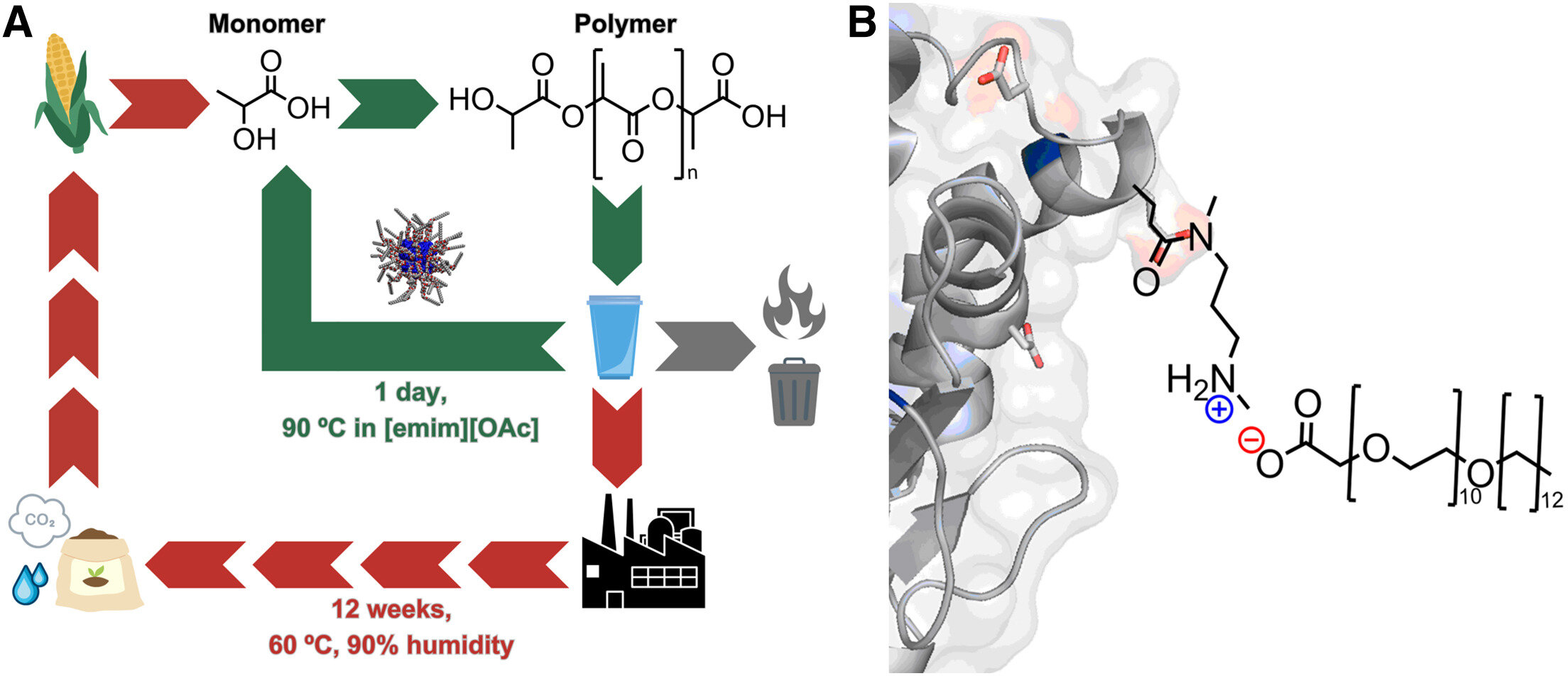博文
洗衣粉中使用的一种酶可以在24小时内回收一次性塑料
 精选
精选
||
洗衣粉中使用的一种酶可以在24小时内回收一次性塑料
诸平
Fig. 1 Credit: Graphical abstract. Cell Reports Physical Science (2024). DOI: 10.1016/j.xcrp.2024.101783
Fig. 2 Biocatalysis of post-consumer poly(lactic acid) using chemically modified lipase B from Candida antarctica. (A) Schematic comparing current industrial composting of PLA (red arrows – PLA is composted, corn is grown, and then fermentation leads to lactic acid) to enhanced chemoenzymatic depolymerization of PLA (blue arrows, this work – the new state of the art). (B) Model illustrating chemical modification strategy showing N,N′-dimethyl-1,3-propanediamine coupled to an aspartic acid side chain with electrostatically conjugated polymer surfactant. Credit: Cell Reports Physical Science (2024). DOI: 10.1016/j.xcrp.2024.101783
据英国伦敦国王学院(King's College London)2024年1月29日提供的消息,伦敦国王学院的科学家们开发了一种用于回收一次性生物塑料的创新解决方案,他们利用洗衣粉中使用的一种酶,可以在24小时内回收一次性塑料(An enzyme used in laundry detergent can recycle single-use plastics within 24 hours),这种塑料通常用于咖啡杯和食品容器等一次性物品。
这种化学回收的新方法于2024年1月29日发表在《细胞报告-物理科学》(Cell Reports Physical Science)杂志网站——Susana M. Meza Huaman, Jake H. Nicholson, Alex P.S. Brogan. A general route to retooling hydrolytic enzymes toward plastic degradation. Cell Reports Physical Science, Available online 29 January 2024, 101783. DOI: 10.1016/j.xcrp.2024.101783. https://linkinghub.elsevier.com/retrieve/pii/S2666386424000031
科学家是使用生物洗衣粉中常见的酶来“解聚”或分解垃圾填埋的生物塑料。在短短24小时内将物品迅速转化为可溶碎片,该过程实现了生物塑料聚乳酸(polylactic acid简称PLA)的完全降解。这种方法比用于回收生物塑料材料(recycling bioplastic materials)的12周工业堆肥过程快84倍。
这一发现为一次性聚乳酸塑料提供了一个广泛的回收解决方案,因为伦敦国王学院的化学家团队发现,在90℃的温度下,再过24小时,生物塑料就会分解成它们的化学组成部分。一旦转化为单体单分子,这些材料就可以变成同样高质量的塑料,可以多次重复使用。
“绿色”塑料的问题(The problem with 'green' plastics)
目前的塑料生产速度超过了我们可持续处理它的能力。据“环境行动”(Environmental Action)组织估计,仅在2023年,全球就有6800多万吨塑料最终进入自然环境,原因是塑料产量巨大,与我们目前管理和回收塑料寿命结束时的能力不平衡。经济合作与发展组织(Organization For Economic Cooperation And Development简称OECD)最近的一份报告预测,到2060年,全球产生的塑料垃圾数量将增长近两倍,其中约一半最终被填埋,而被回收的不到五分之一。
虽然消费者认为从玉米淀粉(corn starch)、木薯(cassava)或甘蔗(sugarcane)等生物来源提取的生物塑料是一种更可持续的选择,但目前的生物塑料生产方法成本高昂,并与粮食农业竞争土地使用。同时,机械回收方法效率低,产生二氧化碳,无法生产高质量的可重复使用材料。这些“绿色”塑料主要在使用一次后就被填埋,导致许多零售商重新使用石油基和化石基材料。
使用这种新方法分解生物塑料的速度可能会彻底改变塑料生产,为回收一次性生物塑料提供高效、可扩展和可持续的蓝图。这项研究在一次性生物塑料的可回收性方面取得了重大突破,为可持续的循环经济(circular economy)开辟了机会,从而消除了化石塑料的生产,并解决了大量最终进入垃圾填埋场和自然环境的塑料废物。
伦敦国王学院化学讲师亚历克斯·布罗根博士(Dr. Alex Brogan)说:“这个项目的灵感来自于医疗和外科产品中使用的生物塑料在体内降解的问题。我们已经扭转了这个问题,并将其应用于回收我们日常生活中使用的一次性生物塑料的问题,使用的是生物洗衣液中发现的一种常见酶。能够利用生物学,通过化学提供可持续的解决方案(sustainable solutions),让我们开始将废物视为一种资源,这样我们就可以摆脱石油和其他不可再生资源,创造我们现代生活所需的材料。”
科学家们现在正在扩大他们的研究范围,以改善其他常用和大量生产的塑料的回收利用,例如用于一次性水瓶/杯、薄膜和塑料片包装以及用于服装的塑料。
伦敦国王学院该项目的研究人员苏珊娜·梅萨·花曼(Susana Meza Huaman)博士说:“我们的研究标志着开发废物管理新技术的第一步,用于回收生物塑料,使其与原始产品质量相同。到目前为止,这一直是塑料回收的主要挑战,因为虽然生物塑料是由生物材料制成的,但它们并不都是可堆肥的,而且目前大多数回收方法效率低下。我们的化学方法大大加快了生物塑料的降解,使它们能够被回收和再利用。”
上述介绍,仅供参考。欲了解更多信息,敬请注意浏览原文或者相关报道。
• Chemical modification of lipase enhances stability and activity in ionic liquids
• Ionic liquids allow for rapid chemoenzymatic depolymerization of PLA at 90℃
• Post-consumer PLA fully water soluble within 24 h
• Post-consumer PLA fully converted to monomer within 40 h
The accumulation of plastic waste in the environment is an ecological disaster that requires a plurality of approaches to tackle. There is therefore an ever-pressing need to close the loop on production of both conventional and bioderived plastics. In response, we propose a generalizable biocatalysis engineering strategy to enhance the use of enzymes to depolymerize a broad class of plastics. To demonstrate this approach, we have solubilized and stabilized the commonly available lipase B from Candida antarctica in ionic liquids. In doing so, we unlock the ability of the enzyme to hydrolytically depolymerize post-consumer poly(lactic acid) plastic, demonstrating full degradation within 24 h and full conversion to monomer within 40 h at 90℃. This facile and scalable modification strategy allows for elevated operation temperatures in combination with the superior solvent capabilities of ionic liquids, providing a blueprint for enhancing the capability of any hydrolytic enzyme for plastic recycling.
https://blog.sciencenet.cn/blog-212210-1419994.html
上一篇:血液检查是诊断老年痴呆症的准确方法
下一篇:线粒体DNA突变的癌症免疫治疗效果提高2.5倍

